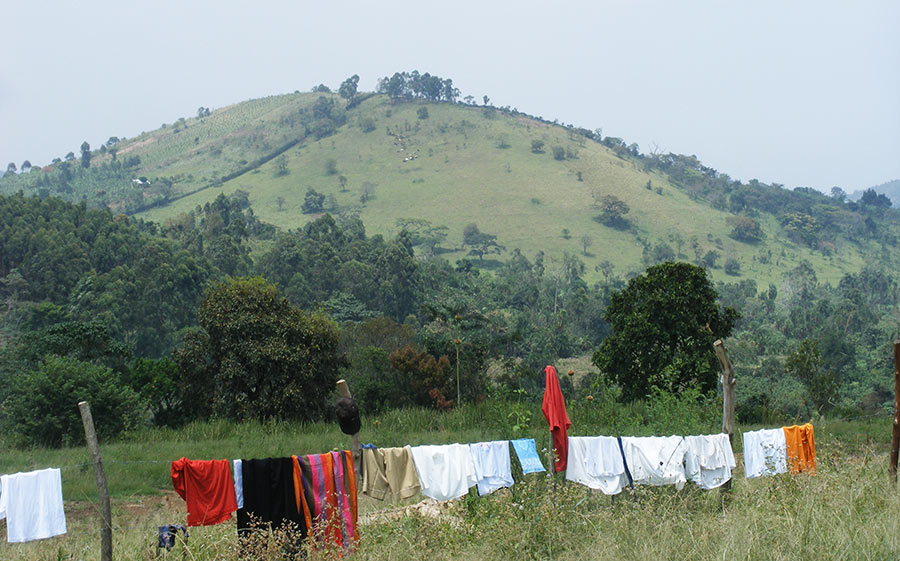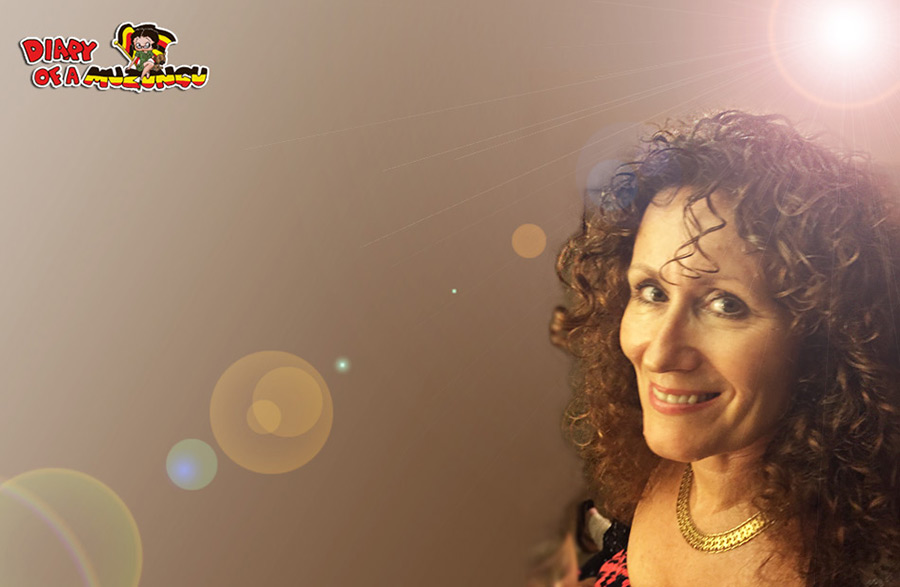
A rainy season journey: nsenene grasshopper road trip to Fort Portal
Our dawn departure from Kampala is marked by streaks of pink and orange daybreak filtering over Port Bell and Lake Victoria. Houselights twinkle in the darkness. Kampala is so pretty at this time of day.
We are driving to Fort Portal. Along Hoima Road, a traffic policeman dressed in white leaps out into the road to intercept a passing saloon car that has large white canvas sacks billowing out of every window.
An excited Julia shouts “nsenene!”
Grasshoppers are back on the menu!

It’s rainy season and there is a glut of nsenene (grasshoppers). The sacks contain live insects that are hung out of the window of the moving vehicle to keep them cool as they are transported to Kampala markets. Ugandans are going crazy for the delicacy, with queues of people lining up downtown to buy them.
Vehicle after vehicle drives towards us laden with white canvas sacks.
It’s 7 o’clock on a November morning.
Julia recounts the story of the day she bought a quarter sack of nsenene on a previous road trip between Fort Portal and Kampala. The kids were screaming with excitement at the thought of feasting on them. Grasshoppers do not have a long shelf life. They have to be ‘cleaned’ (their wings and legs removed) before they can be washed and cooked. Everyone arrived home from the long journey exhausted, she said, but then had to spend several hours plucking off wings and legs! “I think everyone was too sick to eat them after that!”
I remember opening the fridge the next day to find it full of grasshoppers (in addition to the chicken feet and cow hooves reserved for the dog!)

On our journey, Malcolm likes reminding us that Julia was a full-on vegan when they first knew each other many years ago on the Mweya Peninsula in Queen Elizabeth National Park. Back then a grasshopper would not have passed her lips.
At a small trading centre we see some lovely looking chapatis. “Let’s stop for a rolex,” Malcolm says. Everyone loves a rolex. The popular Ugandan street food (of an omelette wrapped in a chapatti) has gone global this year (thanks to an article called ‘The African dishes you should be eating’ on CNN.com)
Our car pulls up next to an open-air butchery. Next to the car, the butcher hacks at a lump of meat with a machete. His face is covered with tiny flecks of meat. Big slabs of beef hang on hooks, intestines lie glistening on a table.
“I’m just going to get some cow hooves for the dogs,” Julia informs me. (Barf. Did you need to tell me? I beg).
As she walks towards the butcher, she stumbles over the head of a recently butchered cow. It sits upside down on the muddy ground, bright red blood draining onto the dark floor. A man straps the cow’s head to the back of his bicycle and wheels it away.
Malcolm gets back into the car frustrated. “That guy has a chapati, the other guy has eggs, but no-one can make me a rolex!” He is on a mission. He decides to return to the stall and get the vendors organised.
Meanwhile, I should not be surprised to see Julia instruct a man to tie a bag of grasshoppers onto the front of our vehicle!

A woman rushes over with a basket of roasted gonja (bananas) on her head. A young man walks up to our parked car and shows me a gold coin. He asks me how much I want to buy it for. He’s trying to sell the muzungu a 20 cent Euro coin. (I wonder if he’s been asking every passing muzungu to buy it).
A happy Malcolm gets back into the car with three monster-sized rolex. The chapatis are thick and well-cooked. They are delicious! We are ten minutes south of Mityana.
“One, two, three, four, five, six, seven, eight, nine, ten, eleven, twelve!” Malcolm counts twelve Great Blue Turacos. “They must have just come out of roost,” he says (meaning the birds have just left their overnight perch).
As we continue our journey towards Fort Portal, more cars come towards us, overloaded with grasshoppers.
“I could carry three sofa sets on the roof of my car today and none of the traffic police would notice!” Exclaims Julia. This morning, the traffic police are only interested in watching the vehicles heading to Kampala.
En route we talk about birds, we talk about conservation, we talk about the many poacher snares and traps that have been recovered by Uganda Conservation Foundation and Uganda Wildlife Authority.
Last time I drove this road I had to slam on the brakes to avoid crashing into a cow that walked straight into the road without looking (it seems to be a Ugandan trait!)
We pass lines of bright shiny corrugated iron sheets, set in horizontal lines to catch grasshoppers. The insects are attracted by a bright light bulb that reflects onto the metal. The insects crash into the metal sheets and land in the buckets at the bottom.

At Mubende, we pull over for Julia to buy some fried grasshoppers and mbuzi roasted ‘goat on a stick’.
“That’s baboon meat!” Shouts Malcolm.
“It’s not baboon!” Laughs the meat-seller.
A man selling water and sodas bangs on the window and tells me to put the window down. I bang back at him angrily. He gets the point and we smile at each other through the glass.
I spot three Hooded Vultures at the top of a tree “the ones with pink necks” I say. The birds’ necks are feather-free to stop them getting covered in blood and core as they eat corpses. “Vultures are known as coprophages,” Malcolm corrects me “because they eat turds!”
Driving through Kiko tea estate, outside Fort Portal, thousands of grasshoppers float above the bright green tea bushes like a layer of green mist. The emergence of grasshoppers floats above the tea and up into the air.
A troupe of eight black and white Colobus Monkeys sit at the top of a tree in a clearing next to the tea plantation. I’m surprised to see them in such an open area. “They do very well in disturbed forest,” Julia – the primatologist – tells us.
We are travelling to Kanyanchu where Julia’s land touches Kibale Forest. For many years she lived in a treehouse in the middle of the forest while she followed, studied and habituated the chimpanzees that are now so popular with tourists.
Malcolm grabs his binoculars to take a closer look at large flocks of Abdim Storks that are circling high in the air, to our left and to our right. “Must be thousands of them,” he says.
According to Fanshawe and Stevenson’s The Birds of East Africa (the best book for identifying Uganda’s birds), Abdim Storks are “nomadic and gregarious.” They are seen in Uganda between October and November as they follow “the rains and burns” on their flight from northern Africa. They are known as “opportunistic” feeders and are undoubtedly making the most of the grasshopper season.
We talk about migration and Malcolm explains how birds use thermals to cover vast distances. “You will notice that vultures are never in the air at the start or the end of the day. They need the hot air rising off the land to allow them to climb high. Vultures can go up 1 or 2 km and then slowly guide for 400 miles. Doing this, they expend very little energy.”
He tells us about a Ruppell’s Griffon Vulture that was seen 12 km above the surface of the earth by a commercial pilot. Vultures have incredible eyesight and watch each other from up on high. I like hanging out with Malcolm Wilson. He is an expert ornithologist and ringer or ‘bander,’ at the very top of his game, and revered by many birders in Uganda. Not only can Malcolm identify a bird, he has a mine of fascinating facts to explain what we’re looking at. “A vulture only drops for one reason: a kill. When one drops out of the sky, the others follow.” Read about his ringing expeditions and bird watching tours across Africa on his web site.

At Tooro Botanical Gardens, a young man called John guides us through the various plants, telling us both the English names and the Latin names. With John’s help, Malcolm and Julia pick out a selection of tree seedlings. Julia and I share a moment of realisation. Julia has been wanting to invite Malcolm to advise her on which plants and trees will help develop her land for birding tourism. Finally we are here. This weekend has been many years in the planning. I am so excited to be part of it.
There is a small fishpond in Tooro Botanical Gardens. It hasn’t been stocked with fish yet but there’s already a heron inspecting it. Julia correctly identifies it as a Black-headed Heron. The girl’s birding knowledge is coming on!

We drive on the new road through Kibale. The Chinese (of course) construction company have been working on it for a couple of years. It’s a good road in many respects but too wide. We bemoan how big and fast the road is. It passes directly through Kibale National Park, described as having “the highest concentration and density of primates in Africa.” We are worried how many of the forest’s animals will be killed by speeding motorists. There are a few road humps but nowhere near enough. We hope and pray that the speed humps will proliferate.
Our car passes through a troop of baboons. One stands on its two back legs to peer into the car looking for food.
I am appalled to see that one of them has had its whole snout (large pointed nose and lips) are missing. Its normally 3D face is flat. His front teeth are permanently visible but beyond this appalling wound, the animal looks healthy enough. Will he survive?
Another baboon, in the bush above the verge, picks at something that it holds in its right paw. It appears to be an animal skin. The baboon pulls the last bits of flesh off some skin “it’s most likely a vervet monkey,” Malcolm says.

At our final destination, Sunbird Hill, Malcolm teaches us all about tree felling and the best plants to attract more birds to the forest edge. It’s an enlightening few days.




























The tourism potential of Uganda is simply unmatched. Unfortunately we are just ‘scratching the surface’. Thank you for this exposure which should bring more tourists here. However, I would like to know your views on the likely adverse effects of oil refining on the sector. Are we not better off selling our oil as crude and keeping our environment clean for posterity (and perpetial tourism revenue), as opposed to chasing after short term gains of a finite resource like oil?
Hi Tom, thanks for dropping by.
I don’t know enough about oil to comment on the pros and cons of refining of it however Uganda will get little financial value if it exports crude. Look at agriculture, for example. If we don’t learn to add value to natural resources, then the country hardly progresses; it just survives.
I wish Uganda were not drilling for oil at all but who can resist the ‘quick win’ of Black Gold? Like you say, it’s a finite resource whereas tourism is not. Tourism employs one in 11 people globally. In Uganda, the estimate of people employed directly or indirectly via tourism is 500,000. That’s huge. Compare that with the number of people employed in the oil industry! Very few of them are Ugandan. Even though there are processes in place to recruit and train Ugandans for the oil industry, the opportunities are comparatively few since employees will have to rack up a number of years’ experience before they can really contribute to the industry. What’s your view?
Having studied and lived in Kenya about 20 years ago, i cannot help but ask the question, ‘why can’t Uganda take lessons from their tourism industry?’. Other than hiring sijui which foriegn firm for thousands of dollars to market our beautiful country yet we have live examples just across. If you visit the white sand beach front hotels in Mombasa you will be awed at how developed their tourism sector is.
I totally agree. Kenya sets the benchmark for tourism promotion in East Africa. I always learn so much from the Kenyan tourism industry. Their standards are high and their marketing is brilliant.
What’s more Kenyans LOVE their nationals parks and beaches: Maasai Mara for Easter breaks and Mombasa for Xmas. We launched #tulambule – the UG version of the #tembeaKenya domestic promotion campaign – but our initiative seems to have fizzled out…
I am not into posting comments but this time I thought I should congratulate you on your blog, as it is Christmas time! I enjoy reading your various stories which depict Uganda as it is. On the issue of tourism, I guess we just have to keep on working at it; we shall finally get there. We just need persistence and some more exposure!
By the way, I am interested in those plants that would lure birds to my garden. Any thoughts?
Dear Panta, lovely to read from you.
Thank you for your positive feedback. Uganda is such a beautiful country, little promotion should be needed, but the reality is there is a lot of competition from established destinations and those with big marketing budgets.
I’m very excited that my family are visiting for Christmas this year. In fact we will spend Christmas Day at Sunbird Hill, admiring the fabulous Kibale Forest. While I’m there, I’ll gather more info about the plants for you. I’ll be in touch! Enjoy the holidays. HAPPY CHRISTMAS
Wow this is travell writting at its best,where have you been or where have i been?
This is thrilling you took me on journey for sure.
Hi David, webale kusima 🙂
I’ve been blogging about Uganda for nine years now… do you travel around UG too?
Impressive writing, fascinating, informative and well illustrated with excellent photos. As a newcomer to this part of Africa, I’m gleaning a lot of useful facts from your diary . . . thank you! Please keep it up.
One question, and I’m sorry if it is negative among all the good things you speak of: is anyone thinking of doing something about the pollution that hangs over Kampala? I wake up high on our hill (Naguru) with the stink of burning fur and animal bones, and guess it comes from the abattoir area near the railway where all the marabou storks hang out?
Hi Ingrid – webale kusima ‘thanks for the appreciation’ – and for taking the time to write.
Yuck, that smell sounds pretty grim.Kampala’s abattoirs are gruesome and medieval by European standards. I’ve toured a few courtesy of Nature Uganda’s annual vulture count. (I was a vegetarian at the time!) Here’s my story: A disgusting day out.Air pollution in Kampala is bad. I don’t know how it is being addressed to be honest but shall ask a friend who monitors it.
What brings you to KLA?
Hello again. Thanks for your reply.
Hubby is here as advisor addressing certain problems on various dams, currently in Uganda. I get to do a stint here and there, accompanied with writing and painting materials, usually out in the sticks. City life makes a change. We love Owena Market; great for some good quality clothes. Not so good for the cages of roosters.
I’m looking forward to catching up with all your diary blogs as I’ve just joined. Cheers!
Dams are interesting – I’ve written about a couple actually.
First blog was about the impact of Bujagali dam (and our last white water rafting trip of Bujagali Falls).
My next dam story was all about Isimba dam – the one that goes online near Jinja soon (well, I’m sure you know that!)
I’m actually writing to you from The Haven. Apparently Isimba dam will not affect the view and the wonderful sound of the white water here but let’s see how the project affects tourism in Jinja overall. Tourism – based majorly around rafting – will inevitably be affected.
There’s not much of Owino market left is there? I was fleeced good and proper there once! Still the best place to buy clothes (though Nakawa market is great, far less congested and slightly cheaper).
What a colourful journey! Grasshoppers are a bit prawn like, but only a bit.
I think you’re closer to the coast than I am … for those of us who can’t get prawns easily, grasshoppers come a close second!